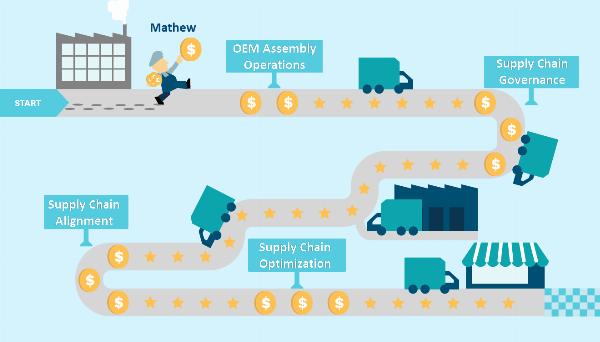The high frequency of warranty parts returns has always been a concern for OEMs. In most cases, this is associated with an inefficient return management system. Most OEMs and suppliers already have a return management system, but it needs to be updated and has flaws.
Manufacturers need an efficient return management process to manage costs and improve product quality.
By identifying patterns that are recurring, OEMs get access to valuable information that contributes to refining the product design, addressing defects, and working on customer satisfaction. Through this blog, let us understand how return management can be optimized through certain practices starting with the purpose of parts return management.
Why is Spare Parts Return Management Essential for OEMs?
Spare parts return management is the process of increasing efficiency, design, and customer satisfaction by analyzing the root cause of warranty parts return. It is executed by conducting tests and research on the parts that are malfunctioning, defective, inefficient, or hampering the performance of other parts present in the machine. OEMS must understand why a part is returned, here are 5 ways to diagnose this efficiently and in time.
5 Ways to Maximize Spare Parts Return Efficiency
An efficient return management system can improve the overall functioning of a business. This includes reduced number of returns, better business operations, efficient design, and much more.
1. Perform Root Cause Analysis (RCA)
Identifying the underlying cause of a recurring defect or failure of equipment is crucial in uncovering the source of problems. Addressing symptoms based on the complaints can temporarily solve the problems but not diagnosing the real cause can trigger the same malfunction or damage again. Root cause analysis usually includes the process of 5 whys and Ishikawa diagrams.
The 5 whys and Ishikawa diagram are the most efficient methods of finding the RCA.
a. 5 Whys
The RCA method of 5 whys involves the technique of consistently asking the question ‘why’ and reasoning each cause until the real cause is determined. Each answer to the question ‘why’ becomes the basis of the next question that comes in line. Finding the reason for each symptom with the question ‘why’ reveals the original cause and analyzes the fault in material, inefficient training, or flaws present in the manufacturing process.
b. Ishikawa Diagram (Fishbone Diagram)
Another method of diagnosing a problem that comes under the RCA includes the visual mapping of the potential cause. This diagram resembles the shape of a fish’s skeleton, where the head of the fish denotes the origin of the problem and the ribs are denoted by the causes of the problem.
Some common causes include people, machines, circumstances, categories, etc. This method ensures that the team conducts a comprehensive analysis of the situation and considers all possible circumstances that could lead to the defect.
2. Integrate Quality Control and Return Data
Return data is an important integration that allows OEMs to analyze existing trends and recurring issues and take necessary action to correct them. The integration of a quality control system with return analytics will allow OEMs to easily automate certain processes that require real-time tracking. Companies have noticed a 20 to 30% increase in efficiency by integrating return data with other software.
3. Invest in Automation
Investing in automation is a great investment for any OEM as it manages and streamlines the process of return management. Automated systems ensure that the tasks are completed on time while reducing human intervention and error. Integrating inventory management software with parts return management software helps OEMs collect accurate information, access real-time visibility of stock levels, and reduce delays. Automating the process with return management and inventory data increases efficiency by 30% while minimizing costs in the long run.
4. Systematic Feedback for the Development Team
Systematically analyzing return trends and accurately managing the data to share with the development team has been fruitful for several OEMs. Targeting feedback along with precise details contributes to refining product quality and decreasing the frequency of returns. Systematically conducting feedback loops ensures that information gained through return data can be effectively utilized for the future growth of the company.
5. Efficient Communication with Supplier
Efficient communication between the supplier and OEM is crucial for effectively retrieving and diagnosing a returned part. The presence of an open and transparent communication system between suppliers and OEMs helps save time going back and forth on disputes. This results in faster resolution of problems and better diagnosis. Several OEMs invest in automating the communication system including notifications regarding return requests.
Benefits of Having an Efficient Return Management Process
1. Reduction in Processing Time
An effective return management process reduces the time taken in managing a return from return request to re-stocking. Companies can make the workflow easier and automate many key tasks such as tracking returns and document processing.
This speeds up returning issues, makes it faster to reintegrate parts back into inventory, and reduces downtime. These systems are usually the streamlined varieties to adopt; this usually has associated processing times that improve by up to 30%. Businesses thus increase productivity and operate effectively.
2. Improved Product Quality
In the return management process, value feedback on recurring defects or failures improves product quality. It means that companies can identify the pattern and underlying issues in manufacturing, design, and materials by systematically analyzing data from returned parts.
This will enable improvements, reducing the chances of further defects. Return feedback is also continuous, thus allowing improvement in product designs as well as manufacturing processes. This consequently results in better quality products and satisfaction to customers.
3. Enhanced Supplier Collaboration
Improved return management promotes OEM-supplier collaboration through better levels of transparency and communication. Efficient return handling enables any company to timely identify defective batches, trace the source of problems, and collaborate with suppliers for problem-solving.
Close collaboration between OEMs and suppliers can ensure faster problem resolution and better control over quality but also create opportunities for taking preventive measures. Companies with efficient return systems and strong communication ties with suppliers find that this leads to higher consistency within their products and fewer disputes over defects.
4. Better Financial Planning
Efficient return management enhances financial planning. It facilitates return rates and processing costs as well as a real insight into the source of defects. This transparency enables companies to predict expenses, optimize the number of inventories, and make resource allocation much more efficient.
Equipped with correct insight as to why the parts were returned, companies can alter procurement and production policies in a manner that will help eliminate and avoid waste. Moreover, efficient return processes minimize labor and handling costs, which directly increases profitability.
Conclusion
Efficient management of spare parts return plays a key role in enabling an OEM to enhance product quality, optimize cost, and ensure business operations are efficiently run. Firms can streamline return processes, minimize downtime, and improve the reliability of products through root cause analysis and automating some of these processes and the use of the data captured better through quality control.
Moreover, the development of greater collaboration with suppliers and well-structured feedback loops result in long-term advantages such as good quality products and cost savings. With proper parts return management solutions, OEMs can not only reduce return rates but also use this information to refine their products as per customer requirements, thus driving business growth and sustainability.
 Don't let your content be flagged with AI Detectors - use a Free AI Humanizer
Don't let your content be flagged with AI Detectors - use a Free AI Humanizer
 Don't let your content be flagged with AI Detectors - use a Free AI Humanizer
Don't let your content be flagged with AI Detectors - use a Free AI Humanizer

















